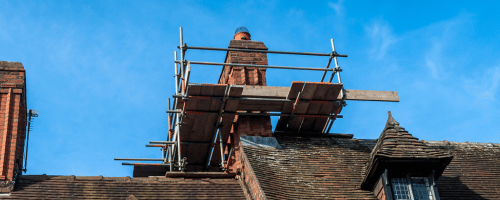Can I Use Insurance for Chimney Repairs in Woodbridge?
In Woodbridge, whether you can use insurance for chimney repairs depends on your policy and the damage’s cause. Generally, policies cover damage from specific perils, such as fire, but often exclude issues like wear and tear. To initiate a claim, it’s crucial to document the damage thoroughly with photos and notes and promptly notify your insurance provider. An adjuster will evaluate the damage to determine coverage eligibility. To understand your options more clearly and find out what steps you should take, additional details are essential.
Key Takeaways
- Insurance coverage for chimney repairs in Woodbridge depends on the cause of damage as outlined in your policy.
- Fire damage is typically covered, while wear and tear may not be eligible for claims.
- Document all damage thoroughly with photos and notes to support your claim.
- Contact your insurance provider to clarify coverage specifics and initiate the claims process.
- Regular maintenance can prevent issues and improve your chances of claim approval for covered perils.
Understanding Insurance Coverage
Understanding insurance coverage for chimney repairs is essential for homeowners to navigate potential claims effectively. Homeowners in Woodbridge should be aware that chimney repair insurance can vary significantly based on various factors, including the cause of damage.
Typically, Woodbridge insurance coverage for chimneys may cover repairs resulting from specific incidents, such as fire damage, while excluding costs related to general wear and tear.
When filing fireplace repair claims, it is crucial to document the damage thoroughly and understand the terms of your policy. Many insurance policies will only cover chimney repairs if the damage is a result of a covered peril. For instance, if a chimney suffers fire damage due to a malfunctioning fireplace, homeowners may be eligible for reimbursement.
Conversely, if the damage stems from neglect or regular deterioration, coverage may be limited.
To ensure you maximize your benefits, homeowners should consult with their insurance providers to clarify the specifics of their coverage. Understanding the nuances of chimney repair insurance can help homeowners make informed decisions and avoid unexpected out-of-pocket expenses when repairs are necessary.
Common Causes of Chimney Damage
Chimney damage can occur due to a variety of factors, each presenting unique challenges for homeowners. One of the most common causes is weather-related deterioration, as exposure to harsh elements like rain, snow, and wind can erode masonry and lead to leaks. Over time, this can compromise the structural integrity of the chimney.
Another significant factor is the accumulation of creosote, a byproduct of burning wood. This flammable substance can build up inside the flue, increasing the risk of chimney fires if not regularly cleaned.
Additionally, improper installation or repairs can lead to issues such as cracking or misalignment, which may require costly corrective measures.
Animal intrusion is another concern, as birds and rodents may build nests within the chimney, obstructing airflow and creating blockages.
Furthermore, the freeze-thaw cycle can exacerbate existing cracks, causing further damage as moisture seeps into the masonry and expands when frozen.
Lastly, neglecting routine maintenance can lead to more severe problems over time. Homeowners should be vigilant about inspecting and maintaining their chimneys to mitigate these common causes of damage effectively.
Fire Damage and Insurance Claims
Experiencing fire damage to your chimney can be a distressing situation for any homeowner, raising immediate concerns about safety and repair costs. When such damage occurs, understanding your insurance policy becomes crucial. Most homeowner’s insurance policies typically cover fire damage, but coverage specifics can vary significantly based on the insurer and the policy terms.
To initiate a claim, it is essential to document the damage thoroughly. Take photographs and gather evidence of the incident, as these will support your claim. Contact your insurance provider promptly to report the damage and start the claims process. Be prepared to provide details about the incident, including how the fire occurred and any immediate steps taken to mitigate further damage.
Once your claim is submitted, an insurance adjuster may visit your property to assess the extent of the damage. They will evaluate whether the repairs are covered under your policy. Understanding your policy limits, deductibles, and any exclusions related to fire damage is vital.
If your claim is denied or you face difficulties, consider consulting with a public adjuster or an attorney specializing in insurance claims to explore your options for appeal.
Wear and Tear Considerations
While fire damage is a significant concern for many homeowners, wear and tear is another factor that can impact the integrity of a chimney over time.
Over years of use, chimneys are exposed to a variety of environmental elements, including moisture, temperature fluctuations, and the byproducts of combustion. These factors can lead to deterioration, such as cracking, crumbling mortar, and flue damage, which may compromise the chimney’s functionality and safety.
Insurance policies typically categorize wear and tear as a maintenance issue, which is often not covered under standard homeowners’ insurance plans. Insurers generally expect homeowners to perform routine maintenance and repairs to prevent deterioration. Consequently, if a chimney’s decline is attributed solely to age and lack of upkeep, a claim for repairs may be denied.
Homeowners should be proactive in maintaining their chimneys, including regular inspections and necessary repairs. Documenting these maintenance efforts can be beneficial when discussing coverage with an insurance provider.
Understanding the nuances of wear and tear in relation to insurance is crucial for homeowners to ensure they are adequately prepared for any needed repairs.
Steps to File a Claim
Filing a claim for chimney repairs requires a systematic approach to ensure that all necessary information is accurately presented to the insurance provider.
Begin by reviewing your insurance policy to understand coverage specifics related to chimney repairs. Identify the cause of the damage, as this will determine eligibility for a claim.
Next, document the damage thoroughly. Take clear photographs from multiple angles and make detailed notes regarding the conditions that led to the need for repairs. If applicable, gather any relevant receipts or maintenance records that illustrate your ongoing care of the chimney.
Once you have collected all necessary documentation, contact your insurance agent to initiate the claim process. Provide them with a summary of the damage and the steps you have taken to document it.
Be prepared to answer any questions and provide additional information if requested.
Finally, follow up regularly to track the status of your claim. Insurance processes can be lengthy, and staying engaged will ensure that your claim is handled efficiently.
Woodbridge’s Go-To Chimney Sweep Professionals
In conclusion, Sixpenny Chimney Sweeps understands that navigating insurance coverage for chimney repairs in Woodbridge requires a clear understanding of your policy details and the cause of any damage. In many cases, fire-related incidents may be covered, but general wear and tear typically isn’t. As trusted chimney sweeps, we advise homeowners to carefully review their insurance policies, assess their coverage options, and ensure they comply with local regulations. By following the necessary steps to file a claim, you can maximize your insurance benefits and manage chimney repairs effectively, helping to keep your home safe and secure.
Sixpenny Chimney Sweeps
Serving Woodbridge, Alexandria, Arlington, VA & Surrounding Areas
(703) 491-8697




Leave a Reply
Want to join the discussion?Feel free to contribute!